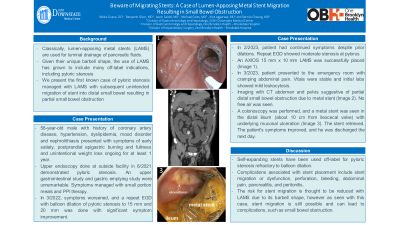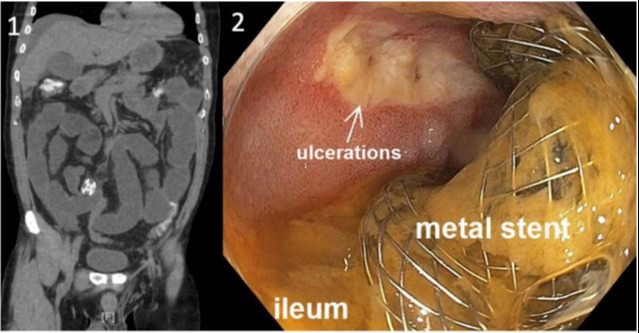Tuesday Poster Session
Category: Stomach
P4206 - Beware of Migrating Stents: A Case of Lumen-Apposing Metal Stent Migration Resulting in Small Bowel Obstruction
Tuesday, October 24, 2023
10:30 AM - 4:00 PM PT
Location: Exhibit Hall

Has Audio
- NG
Nikita Gupta, DO
SUNY Downstate Health Sciences University/NYCHHC Kings County Hospital
New York, New York
Presenting Author(s)
Nikita Gupta, DO1, Benjamin S. Silver, MD2, Jason Saltiel, MD2, Michael Coles, MD2, Derrick Cheung, MD3
1SUNY Downstate Health Sciences University/NYCHHC Kings County Hospital, New York, NY; 2SUNY Downstate Health Sciences University, Brooklyn, NY; 3One Brooklyn Health, Brooklyn, NY
Introduction: Classically, lumen-apposing metal stents (LAMS) are used for luminal drainage of pancreatic fluids. Given their unique barbell shape, the use of LAMS has grown to include many off-label indications, including pyloric stenosis. We present the first known case of pyloric stenosis managed with LAMS with subsequent unintended migration of stent into distal small bowel resulting in partial small bowel obstruction.
Case Description/Methods: 58-year-old male with history of coronary artery disease, hypertension, dyslipidemia, mood disorder and nephrolithiasis presented with symptoms of early satiety, postprandial epigastric burning and fullness and unintentional weight loss ongoing for at least 1 year. The patient was previously assessed at an outside facility in 6/2021 where upper endoscopy (EGD) demonstrated pyloric stenosis. An upper gastrointestinal study and gastric emptying study were unremarkable. Symptoms were managed with small portion meals and proton pump inhibitor therapy. In 3/2022, symptoms worsened, and a repeat EGD with balloon dilation of pyloric stenosis to 15 mm was done with significant symptom improvement. Patient underwent repeat dilation up to 20 mm. In 2/2023, patient had continued symptoms despite prior dilations, therefore repeat EGD was performed and showed moderate stenosis at pylorus and an AXIOS 15 mm x 10 mm LAMS was successfully placed. In 3/2023, patient presented to the emergency room with complaints of cramping abdominal pain. Vitals were stable and initial labs significant for mild leukocytosis. Imaging with CT abdomen and pelvis suggestive of partial distal small bowel obstruction due to metal stent. No free air was seen. A colonoscopy was performed, and a metal stent was seen in the distal ileum (about 10 cm from ileocecal valve) with underlying mucosal ulceration. The stent retrieved. The patient's symptoms improved, and he was discharged the next day.
Discussion: Self-expanding stents have been used off-label for pyloric stenosis refractory to balloon dilation. Complications associated with stent placement include stent migration or dysfunction, perforation, bleeding, abdominal pain, pancreatitis, and peritonitis. The risk for stent migration is thought to be reduced with LAMS due to its barbell shape, however as seen with this case, stent migration is still possible and can lead to further complications, such as small bowel obstruction. It is imperative that these complications are considered prior to stent placement.

Disclosures:
Nikita Gupta, DO1, Benjamin S. Silver, MD2, Jason Saltiel, MD2, Michael Coles, MD2, Derrick Cheung, MD3. P4206 - Beware of Migrating Stents: A Case of Lumen-Apposing Metal Stent Migration Resulting in Small Bowel Obstruction, ACG 2023 Annual Scientific Meeting Abstracts. Vancouver, BC, Canada: American College of Gastroenterology.
1SUNY Downstate Health Sciences University/NYCHHC Kings County Hospital, New York, NY; 2SUNY Downstate Health Sciences University, Brooklyn, NY; 3One Brooklyn Health, Brooklyn, NY
Introduction: Classically, lumen-apposing metal stents (LAMS) are used for luminal drainage of pancreatic fluids. Given their unique barbell shape, the use of LAMS has grown to include many off-label indications, including pyloric stenosis. We present the first known case of pyloric stenosis managed with LAMS with subsequent unintended migration of stent into distal small bowel resulting in partial small bowel obstruction.
Case Description/Methods: 58-year-old male with history of coronary artery disease, hypertension, dyslipidemia, mood disorder and nephrolithiasis presented with symptoms of early satiety, postprandial epigastric burning and fullness and unintentional weight loss ongoing for at least 1 year. The patient was previously assessed at an outside facility in 6/2021 where upper endoscopy (EGD) demonstrated pyloric stenosis. An upper gastrointestinal study and gastric emptying study were unremarkable. Symptoms were managed with small portion meals and proton pump inhibitor therapy. In 3/2022, symptoms worsened, and a repeat EGD with balloon dilation of pyloric stenosis to 15 mm was done with significant symptom improvement. Patient underwent repeat dilation up to 20 mm. In 2/2023, patient had continued symptoms despite prior dilations, therefore repeat EGD was performed and showed moderate stenosis at pylorus and an AXIOS 15 mm x 10 mm LAMS was successfully placed. In 3/2023, patient presented to the emergency room with complaints of cramping abdominal pain. Vitals were stable and initial labs significant for mild leukocytosis. Imaging with CT abdomen and pelvis suggestive of partial distal small bowel obstruction due to metal stent. No free air was seen. A colonoscopy was performed, and a metal stent was seen in the distal ileum (about 10 cm from ileocecal valve) with underlying mucosal ulceration. The stent retrieved. The patient's symptoms improved, and he was discharged the next day.
Discussion: Self-expanding stents have been used off-label for pyloric stenosis refractory to balloon dilation. Complications associated with stent placement include stent migration or dysfunction, perforation, bleeding, abdominal pain, pancreatitis, and peritonitis. The risk for stent migration is thought to be reduced with LAMS due to its barbell shape, however as seen with this case, stent migration is still possible and can lead to further complications, such as small bowel obstruction. It is imperative that these complications are considered prior to stent placement.

Figure: 1. CT scan demonstrating metal stent in distal small bowel
2. Colonoscopy findings of stent in distal ileum
2. Colonoscopy findings of stent in distal ileum
Disclosures:
Nikita Gupta indicated no relevant financial relationships.
Benjamin Silver indicated no relevant financial relationships.
Jason Saltiel indicated no relevant financial relationships.
Michael Coles indicated no relevant financial relationships.
Derrick Cheung indicated no relevant financial relationships.
Nikita Gupta, DO1, Benjamin S. Silver, MD2, Jason Saltiel, MD2, Michael Coles, MD2, Derrick Cheung, MD3. P4206 - Beware of Migrating Stents: A Case of Lumen-Apposing Metal Stent Migration Resulting in Small Bowel Obstruction, ACG 2023 Annual Scientific Meeting Abstracts. Vancouver, BC, Canada: American College of Gastroenterology.
